Shed Maintenance
OK you have built your shed. What now? What is required in the way of shed maintenance? Is there a list of ongoing jobs that are needed to keep the shed in good shape?
Hopefully the memory of your shed building project can stay just that a happy memory. As you go on to appreciate the benefits of owning a small building. For your hobby, your business, for leisure, for the storage space freed up in the house....
There will however be some ongoing work every now and then to keep the building watertight and serviceable.
Shed Audit - Your annual shed maintenance check
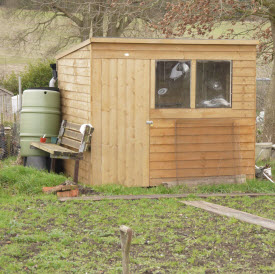
A quick look over the shed once a year looking for problems is probably the most efficient way of checking that everything is OK. Time flies and before you know it the roof has rotted, trees have grown up etc. So I recommend a Shed Audit once a year.
A Shed Audit takes 15 minutes or so at the same time each year.
Read more about how the Shed Audit will save you both time and money.Maintain the stain to keep your shed looking good and the water out
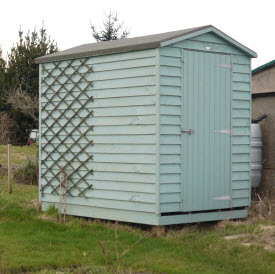
Perhaps the most regular shed maintenance job will be the occasional re-painting with a good quality water repellent exterior woodstain
Equip yourself with the knowledge to choose between shed paint and wood stain for durable shed cladding protection
Help with selecting the best method of applying paint or woodstain to your shed.
Keep the roof in good condition to shed water
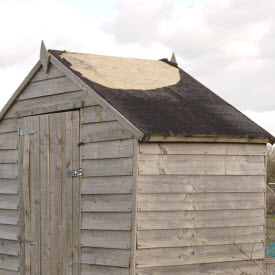
Check the roof for signs of damage or an indication that the roof covering has come to the end of its life.
This article on Shed Roofing Materials gives a good indication of the expected life of several roof materials.
My current recommendation for a replacement shed roof is the economical and long lasting (50 years) epdm rubber roof.
Rather than traditional bituminous roof felt.
If you fail to spot and act on the tell-tale signs of a leaking roof you might be in for some extensive shed roof repairs.
Keeping water out doesn't end with the roof
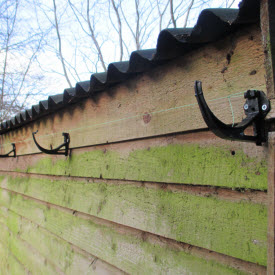
Water is the main enemy of your shed installing plastic guttering to capture and control water from the roof can prevent damage to the structure of the building.
Read more on how to install plastic guttering.If you have a store-bought shed that is proving problematic you might want to a consider retrofit upgrade
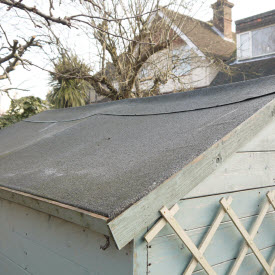
A forthcoming article shows four ways that you can improve and strengthen your shed to prolong its life and reduce the amount of shed maintenance required to keep it good condition.
Keep the area around your shed free of vegetation and debris
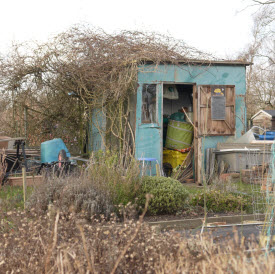
You have probably seen some lovely pictures of overgrown sheds. They look lovely but are probably a bit of a nightmare to look after. Vegetation growing close to a shed often damages them, fallen branches, vegetation blowing in the wind knocks guttering off, the build-up of leaves around a shed base promotes rotting at the base of the wall and shed floor. I'm not saying don't grow plants near your shed. Just be very aware of the impact that they have on the building and the extra work that this will entail.
Foundation problems
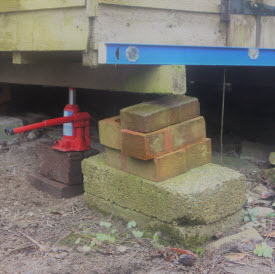
Most sheds rest very lightly on the earth. Also being small structures if one part moves then the rest of the building will move too. Problems with shed foundations do arise sometimes from water draining from the roof and shallow clay foundations, or a whole host of other reasons. The great thing is that these problems are for the most part solvable.
Forthcoming article - How to jack-up and underpin a shed.
Sign up for Shed Building Monthly to make sure you don't miss future articles.What happens if you don't keep up your shed maintenance?
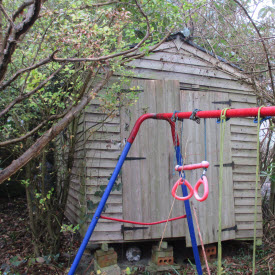
Not much initially! But over the years it adds up. Coming soon an article about what happens if vegetation is allowed to grow up close to the shed, roof water isn't controlled and debris is allowed to build up around the base of the shed.
However even if you do neglect your shed for a period it may not be beyond repairSign up to Shed Building Monthly to find forthcoming articles on:
- How to winch a shed to correct damage
- How to replace rotten shed siding and structural timbers
Conclusion
Hopefully it won't get to the above actions to rescue your shed. You have probably heard the old saying 'a stitch in time saves nine'. This is so true when it comes to looking after your shed.
Spot the problems early by carrying out your annual Shed Audit and act on what you find. Doing so will give you lots more free time to enjoy the real purpose that you built your shed.

Keep in touch with our monthly newsletter
Shed Building Monthly



